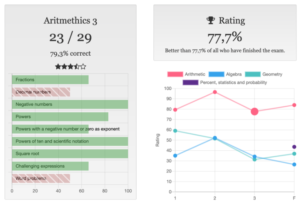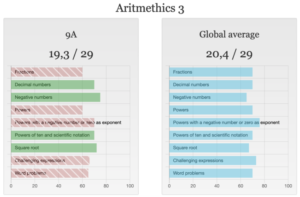I am not a huge fan of traditional exams. This will come as no surprise for those who know me or follow my blog. Two years ago I decided not to use any exams at all when teaching mathematics and there were no real drawbacks to this, in fact it was quite the opposite. By not having any exams I showed that it can be easier to create an interest for mathematics, which is an important factor in learning, so therefore the students learned mathematics just as well or even better than before when I used to have exams. If you are interested to read the full story on this then please press here.
With that said, I do believe that using exams can be useful if the results are not subjective to the teacher, and that the exams provide information on exactly what the students need to practise more and offers a way for them to do so. It would also be great if the results would provide information on students’ progress throughout the school years. The problem with traditional exams is that they do not meet these criteria and therefore they have to be improved, and this is exactly why Ma.fi has worked on developing Mafitional exams.
 How does Mafitional exams differ from traditional exams? Mafitional exams are international exams where students’ results are compared to all Ma.fi users in all countries. The exams are designed to follow up students’ development in arithmetics, algebra and geometry in junior high. Each of these areas consists of four exams which makes it possible to follow student’s progress in each specific area and at the same time offer an objective result. For example, after completing an exam the student will be provided with the following information: “you had 80% correct which is better than 70% of all other results”, and since each area has four exams the student can follow his or her progression with a simple graph. But this is not all. The student will also be able to see statistics over the results of the various sub-areas in the exam. For the sub-areas where the student has received below 65% correct, the student will receive compulsory tasks that must be performed before the Mafitional exam can be approved.
How does Mafitional exams differ from traditional exams? Mafitional exams are international exams where students’ results are compared to all Ma.fi users in all countries. The exams are designed to follow up students’ development in arithmetics, algebra and geometry in junior high. Each of these areas consists of four exams which makes it possible to follow student’s progress in each specific area and at the same time offer an objective result. For example, after completing an exam the student will be provided with the following information: “you had 80% correct which is better than 70% of all other results”, and since each area has four exams the student can follow his or her progression with a simple graph. But this is not all. The student will also be able to see statistics over the results of the various sub-areas in the exam. For the sub-areas where the student has received below 65% correct, the student will receive compulsory tasks that must be performed before the Mafitional exam can be approved.
 All of this solves the problem with providing a universal result and makes sure that students become aware of where they need to practice more. But all this information makes it possible to take things one step further. Now it is not only the students who can learn from the results, but also the teacher. Obviously the teacher will be able to see the students’ results and the classes’ progression, but in addition the teacher will find out how well a class is doing in the different sub-areas of the exam compared to the global result. With this information the teacher will know exactly what the students have learned well and where some extra effort might be in place.
All of this solves the problem with providing a universal result and makes sure that students become aware of where they need to practice more. But all this information makes it possible to take things one step further. Now it is not only the students who can learn from the results, but also the teacher. Obviously the teacher will be able to see the students’ results and the classes’ progression, but in addition the teacher will find out how well a class is doing in the different sub-areas of the exam compared to the global result. With this information the teacher will know exactly what the students have learned well and where some extra effort might be in place.
Why the team of Ma.fi decided to create these Mafitional exams is obviously to provide students and teachers with information that can help improve learning. There is, however, a hidden bonus with all of this information. After a student has completed all final exams in each area, the student will be given a final rating, and this rating can be used as a guideline for handing out fair grades after completing junior high.
Even though I have been skeptic towards use of exams in the past, I must say that I am excited about these exams since I hope that they will provide me with information that will improve my teaching. I am also curious to find out how much impact this will have on students’ learning and how they and their guardians think of this. I am of course also interested in finding out if other teachers find these exams helpful, so in the upcoming months I will gather this information and publish it in a later post. What is your initial reaction?
Ma.fi is a digital math book created in Finland for junior high with an internationally compatible curriculum. Ma.fi is available in English, Swedish and Finnish and follows the student centered model. Aside from the Mafitional exams Ma.fi has developed many other tools and functions that support student learning.
